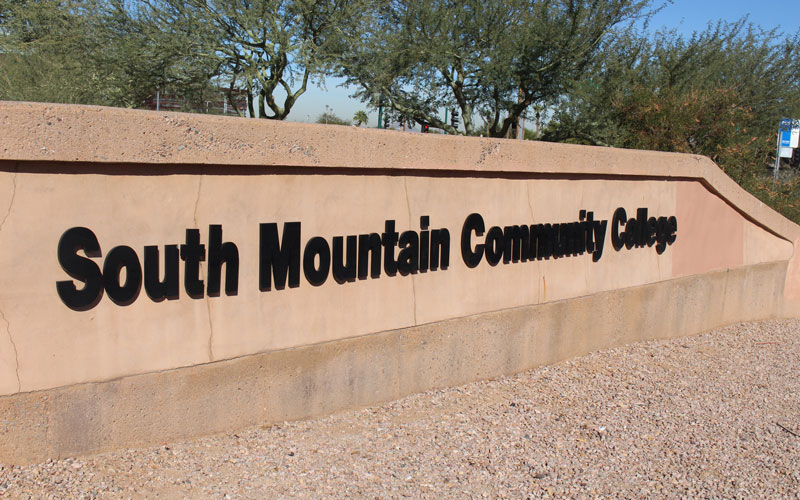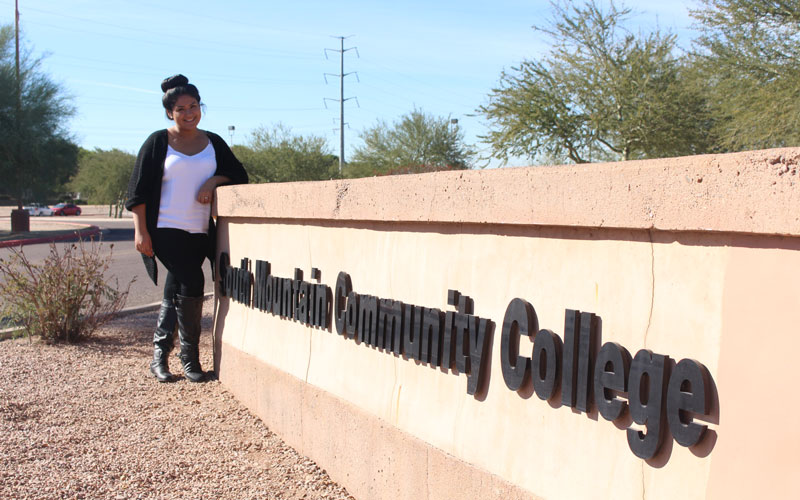
South Mountain Community College, located at 7050 S 24th St., like community colleges across the country, struggles with retaining full-time and part-time students. (Photo by Sophia Kunthara/Cronkite News)

Joana Sotelo, 19, plans on transferring to ASU to pursue a degree in Justice Studies and go on to law school. (Photo by Sophia Kunthara/Cronkite News)
The call came two weeks before Joana Sotelo’s birthday in February 2013: her brother had been deported to Mexico.
“When something emotional comes to your life, it just makes you want to work harder for what you want,” Sotelo said. “It just gave me more of a reason to work toward my goals.”
For Sotelo, a first-generation college student at South Mountain Community College, that goal was to obtain a college education and become an immigration lawyer. She wanted to attend Arizona State University after high school, but couldn’t afford it.
Her mother works as a supervisor of housekeeping at the Paradise Valley Country Club and her father is a landscaper. Sotelo is the first of her five siblings to pursue a higher education.
A Presidential Honor scholarship made community college possible and Sotelo is on track to graduate in the spring before hopefully transferring to ASU to major in Justice Studies.
For Sotelo, SMCC was the first step.
SMCC, located at 7050 S. 24th St., serves some of the poorest areas of the Valley, including South Phoenix, Guadalupe and Laveen. In its zip code, 85042, only 22 percent of the population over 25 years old has a bachelor’s degree or higher, according to census data. In its congressional district, District 7, about 35 percent of the people fall below the poverty line.
The college, opened at its current location in 1981, had slightly more than 4,000 students in the fall semester of 2015, 32 percent of them full-time students, 68 percent part-time.
“Here in this community, we don’t really have access to schooling if it weren’t for this school … built 30-something years ago,” Sotelo said. “We didn’t really have anything over here in this area. We don’t have hospitals… we don’t have schools.”
“So I feel like it being built, it has been the first step to many, three generations now. It’s been 30 years, and it will continue to be the first step to many first-generation students here.”
But SMCC, like many community colleges around the nation, faces low retention and graduation rates. Only 29 percent of part-time students and 60 percent of the full-time students who enrolled at the college in Fall 2013 returned the next year.
Compared to the nine other colleges in the Maricopa County Community College district, SMCC ties for the fifth-lowest full time retention rate and the second-lowest part-time retention rate.
From the fall 2014 semester to fall 2015, the full-time headcount dropped by about 2.25 percent and the part-time headcount fell by about 5.9 percent.
The district, which includes 10 community colleges, a corporate college and two skill centers, operates as “a community of colleges — colleges for the community” to provide higher education to the diverse populations it serves, according to the district’s strategic plan for 2013-2016.
Tuition also is significantly cheaper than at four-year universities; SMCC charged $84 per credit hour for Maricopa County residents during the spring 2014 semester.
Additionally, the district is aiming to increase the number of students obtaining their associate degrees and certificates or transferring to a university in Arizona by 50 percent by 2020. “Attaining this goal will contribute to Arizona’s economic recovery as well as increase the quality of life for a more educated workforce,” according to the district plan.
Without the college, there would be no other opportunity to achieve a higher education and increase the earning power for students like Sotelo.
“If it wasn’t for the scholarship, I’d still be at home scraping dishes somewhere,” she said.
When community colleges first began, the goal was to provide access to education, according to Callan Fay, a student success specialist at SMCC. But the focus has shifted by using data to identify students’ strengths and help them identify career paths and study plans that play to their strengths and encourage them to finish their degree.
Nationally, retention rates for full and part-time students also have been problematic for community colleges.
Hana Lahr, a senior research assistant at the Center for Community College Research at Columbia University, said because community colleges don’t have programs with set plans of study, students often take a variety of courses that do not lead to an end goal.
“The problem when it comes to retention is because they are disconnected, they’re not set up to maximizing retention or completion,” Lahr said. “When a student comes in, they’re taking these courses, the programs aren’t clearly laid out … the programs of study aren’t coherent, they’re disconnected.”
Some students have to take multiple remedial education classes as well, which can prolong their time in college.
But having doubts about what classes to take and what career path to pursue isn’t limited to community colleges, said Osaro Ighodaro, the vice president of student development at SMCC. Ighodaro, who worked at ASU for years, said students starting college at a four-year university also struggle to stick to their study plan.
But more community college students are first-generation or non-traditional students from lower-income families.
“Because of the socio-economic status of the majority of our students, again you have the population in the university but less so than in community college, part of the challenge is students having to work two, three jobs to have an apartment, fend for their family and having to go to school,” Ighodaro said.
Nationally, 44 percent of low-income students attend community college after high school, while only 15 percent of high-income students attend community college to start their higher education, according to the Community College Research Center’s analysis of the Education Longitudinal Study.
Ighodaro noted that SMCC has some programs to help students whose education may be hindered by lack of financial support. A food pantry stocked by faculty, for example, is on campus for students who come to campus hungry. It’s not funded by the college or district, but something faculty do to help the students.
Lower-income and many minority students also are less familiar with college environments and don’t know about the resources available to them, she said.
“Being a first generation minority is tough, because when you need help with your homework and stuff, mom and dad can’t help you,” Sotelo said.
Sotelo works at the college’s Learning Resource Center, where students come to study or for tutoring. She works at the front desk 15 hours a week as part of her work-study program.
For many students at the South Phoenix campus, this is not only their best shot at a college degree, it’s their only shot.
Chasity Chase grew up on the Navajo reservation. Her father told her to focus on one thing: getting an education. With few opportunities near the reservation, Chase saw moving to the Valley as the only option, despite her lack of knowledge about life outside of the reservation.
She didn’t even own a cell phone.
“He always stressed ‘get an education, that’s where you’ll get the money, I don’t want you struggling like the rest of the people moving from place to place with construction jobs,’ ” Chase said.
The mother of four, she moved to South Phoenix and enrolled at SMCC to pursue a career in psychology. SMCC was close to her South Phoenix home, affordable and had flexible classes. She was able to make money doing general labor at construction sites on the side, often doing the cleanup work.
She plans to return to the reservation when she’s done.
“That’s my motivation for that, just to go back home and educate people, more awareness for the outside world,” Chase said.
Since Sotelo enrolled in SMCC, even her mother has expressed an interest taking classes.
“I think people don’t think of doing something until they see it, they see other people doing it…I didn’t see my older brothers go to college, but I’m being the first person to go to college, Sotelo said.
“They (her younger brothers) are seeing me do it, so other people around this community are going to be like ‘Hey, someone else did it. I can too.’ ”